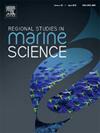Exploring the association between the arrow crab Stenorhynchus lanceolatus (Brullé, 1837) and the sea anemone Telmatactis cricoides (Duchassaing, 1850) in the Canary Islands
IF 2.1
4区 环境科学与生态学
Q3 ECOLOGY
引用次数: 0
Abstract
Symbiotic relationships are common in marine ecosystems, especially between cnidarians and crustaceans. This study explored the association of the arrow crab Stenorhynchus lanceolatus with different hosts in the Canary Islands, focusing on the relationship with the sea anemone Telmatactis cricoides. Field surveys and laboratory experiments were conducted to assess crab preference among potential hosts (anemones and sea urchins), association rates and behaviours of crabs interacting with the anemone. Field results revealed similar prevalence on anemones and sea urchins, and that most crabs associated to the anemone were solitary females. However, under laboratory conditions, sea urchins were observed to be preferred as hosts, but association with anemones were more stable in time, although its colonization period was slower, likely due to their toxicity and lack of environmental cues. Additionally, crab intraspecific competition seemed to favour the association with the anemone. This study showed the mutualistic and facultative nature of the relationship between S. lanceolatus and T. cricoides, advancing our understanding of benthic ecosystems dynamics.
求助全文
约1分钟内获得全文
求助全文
来源期刊

Regional Studies in Marine Science
Agricultural and Biological Sciences-Ecology, Evolution, Behavior and Systematics
CiteScore
3.90
自引率
4.80%
发文量
336
审稿时长
69 days
期刊介绍:
REGIONAL STUDIES IN MARINE SCIENCE will publish scientifically sound papers on regional aspects of maritime and marine resources in estuaries, coastal zones, continental shelf, the seas and oceans.
 求助内容:
求助内容: 应助结果提醒方式:
应助结果提醒方式:


